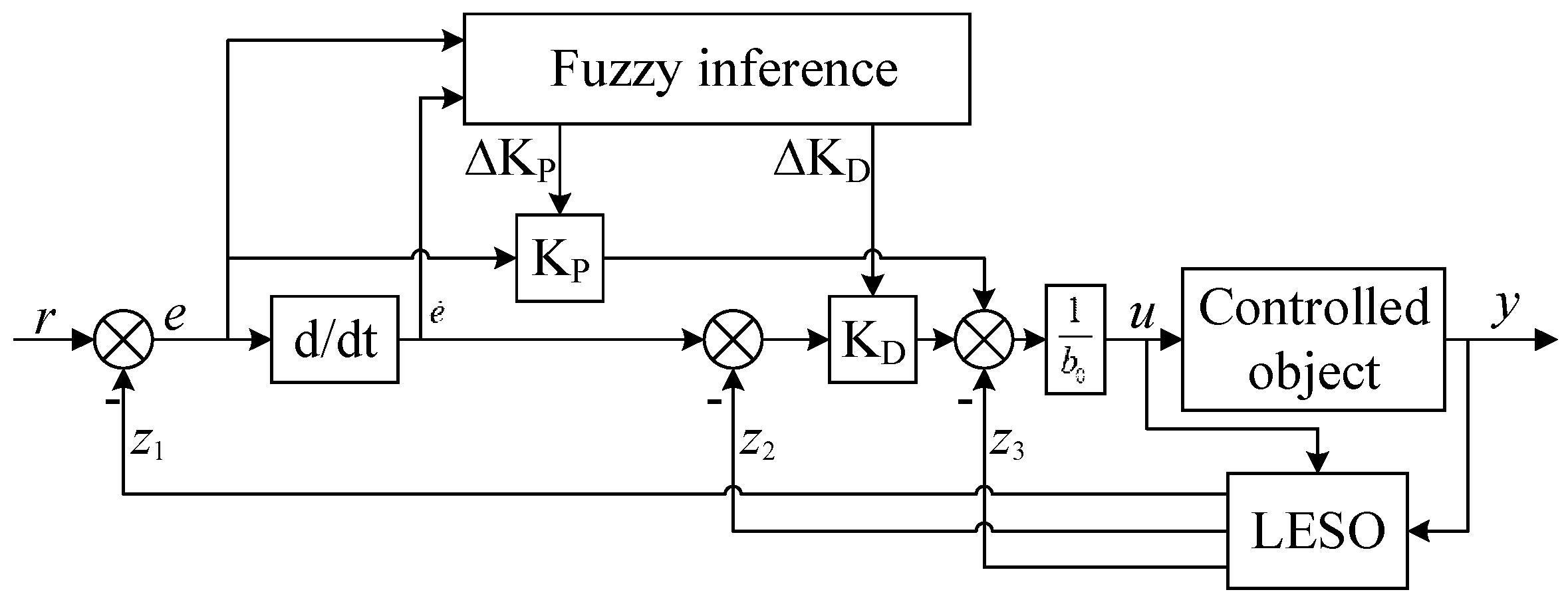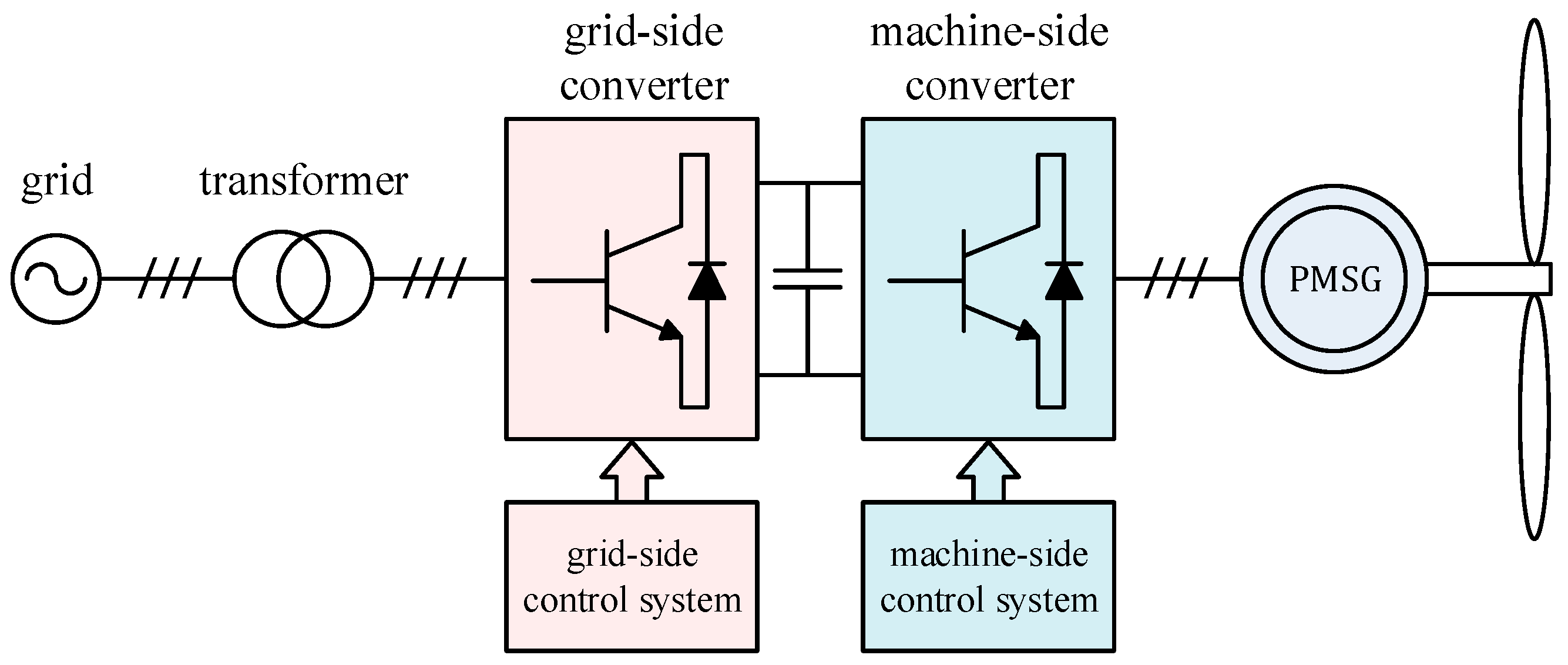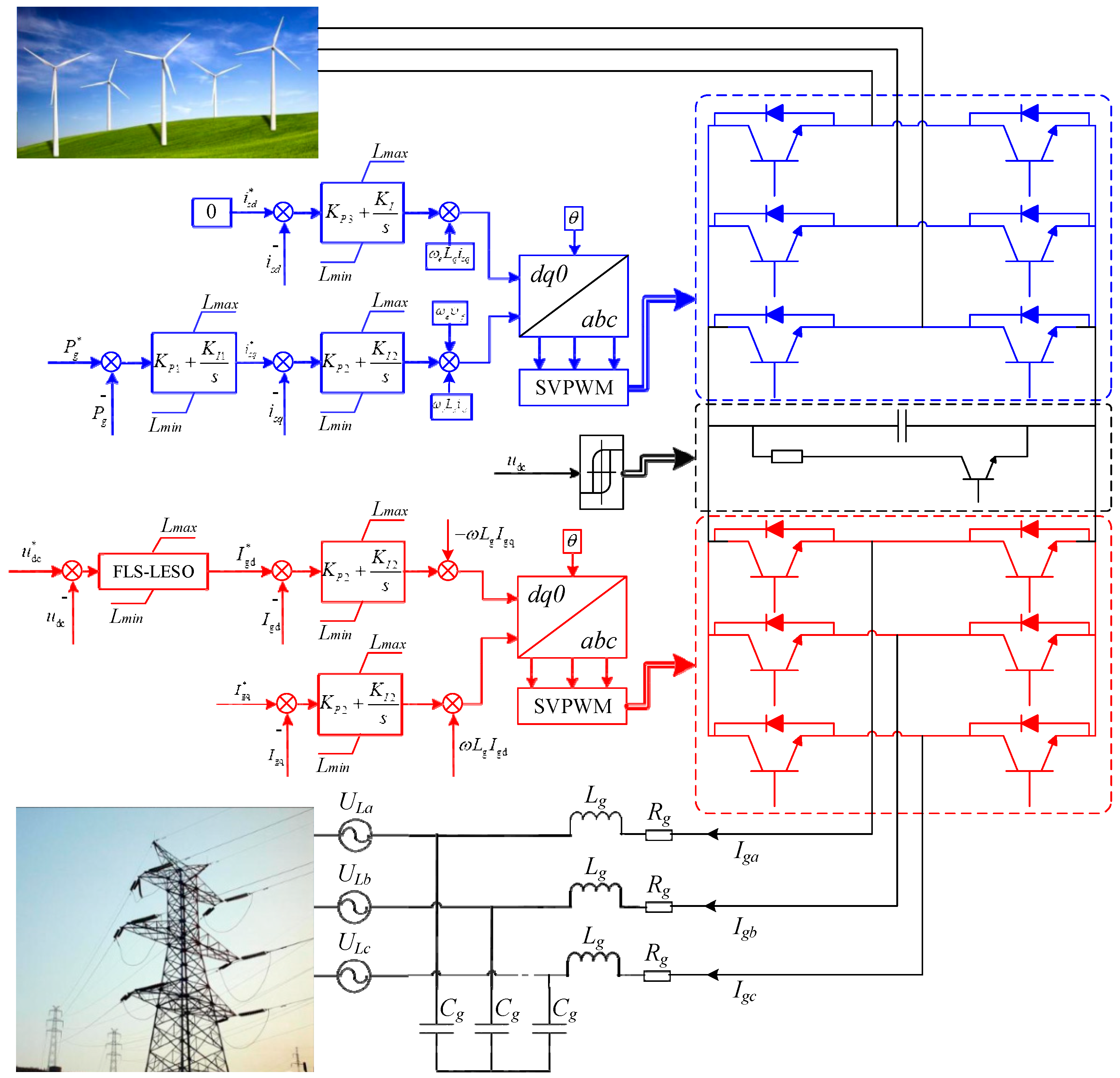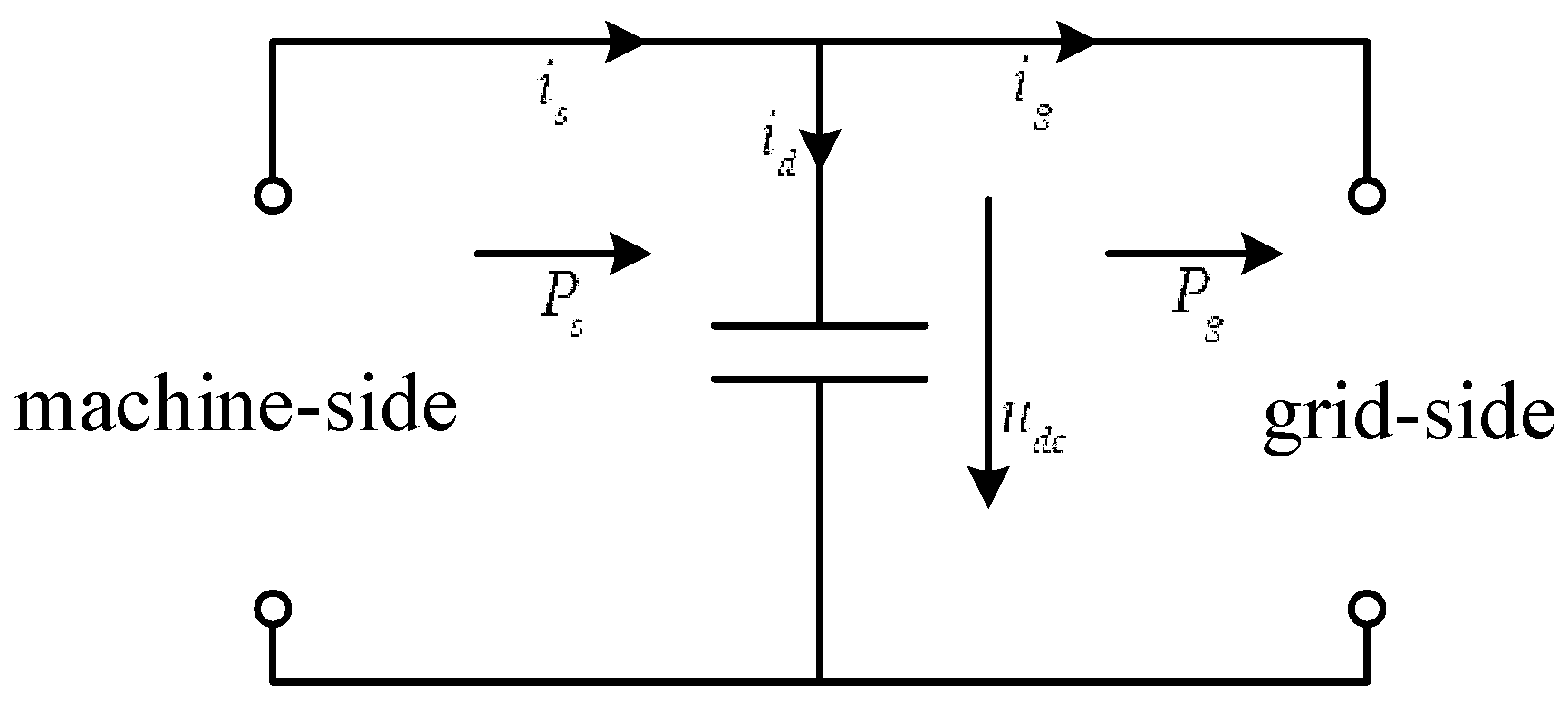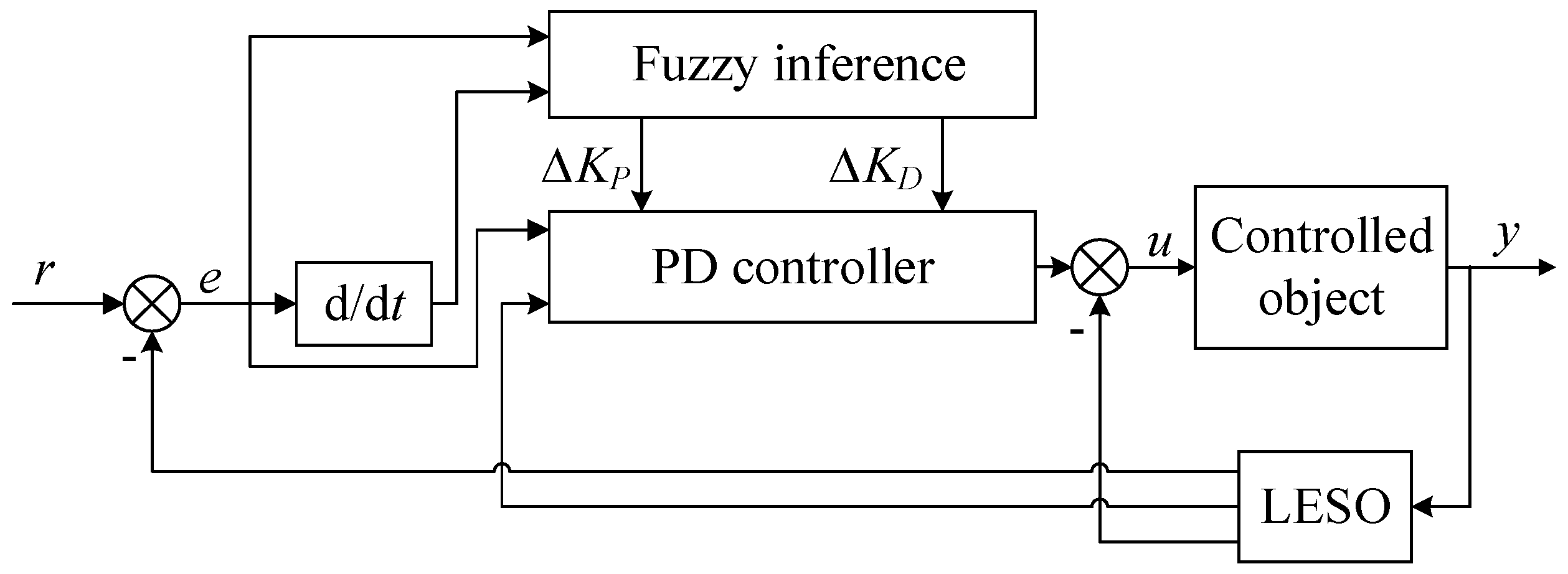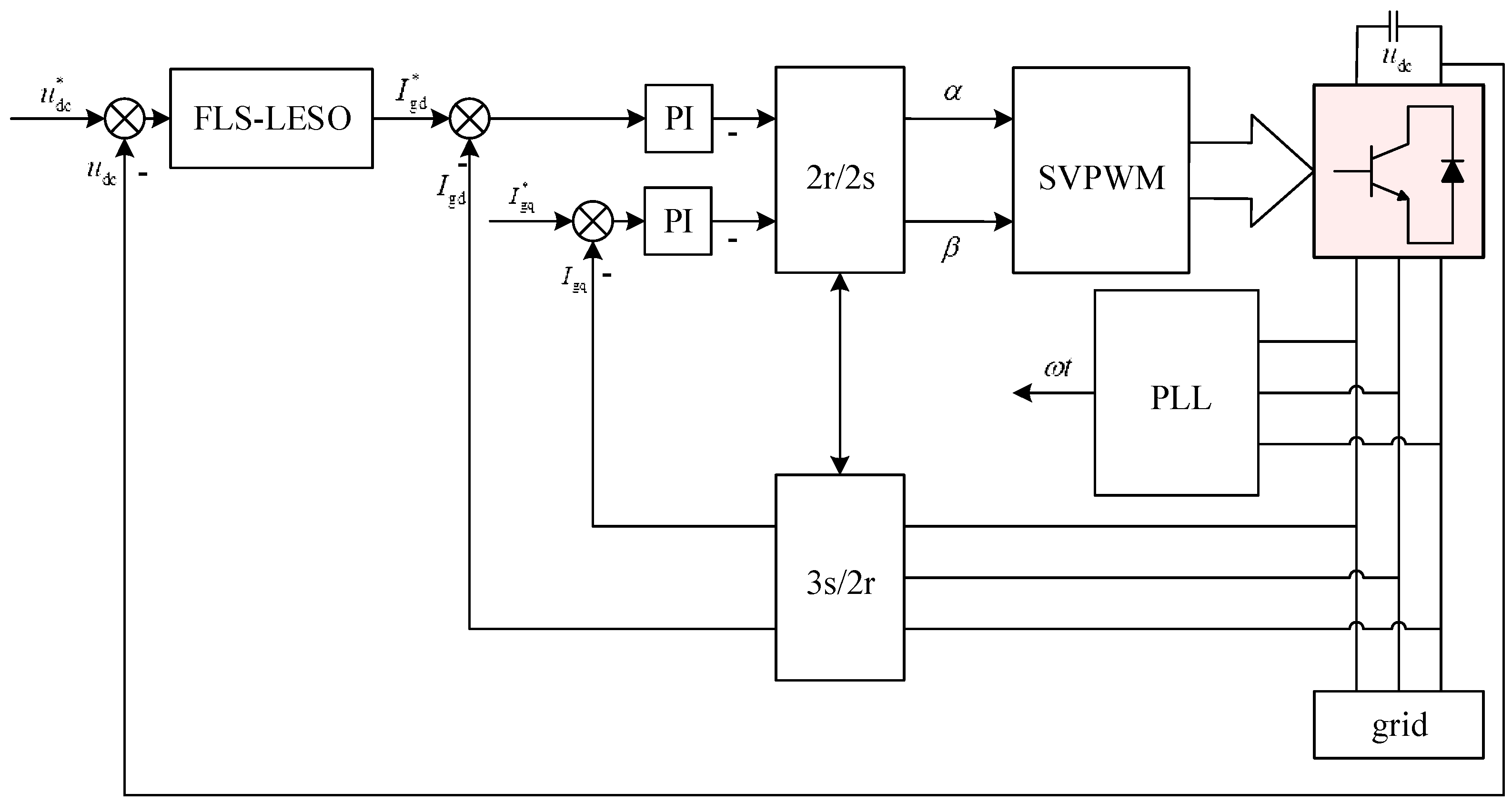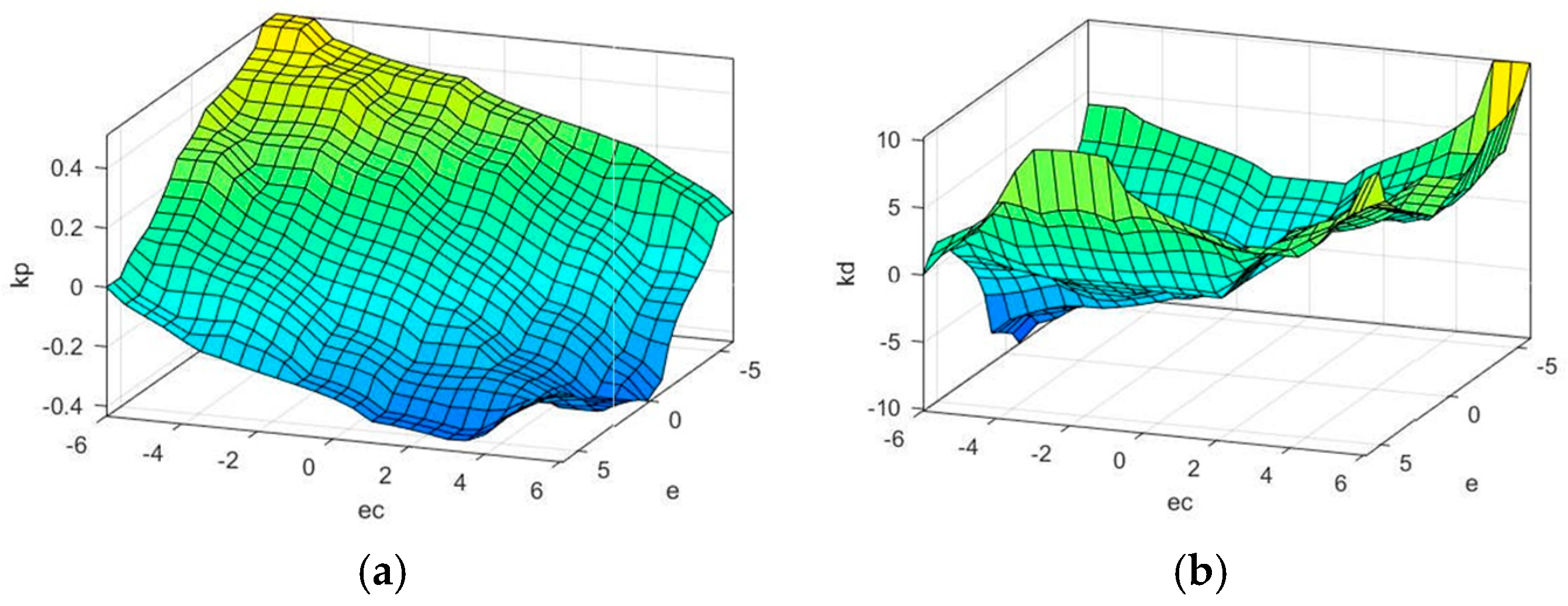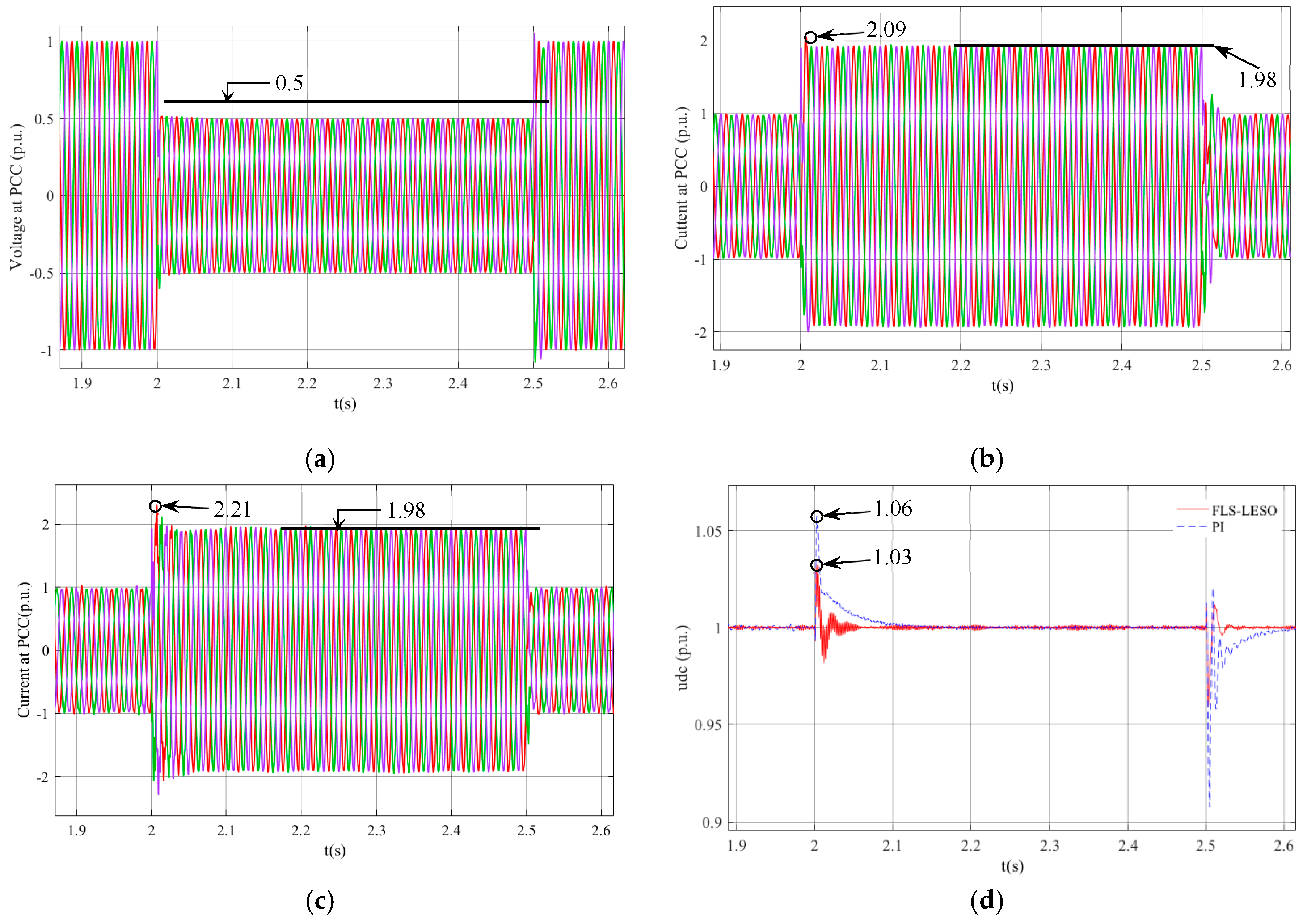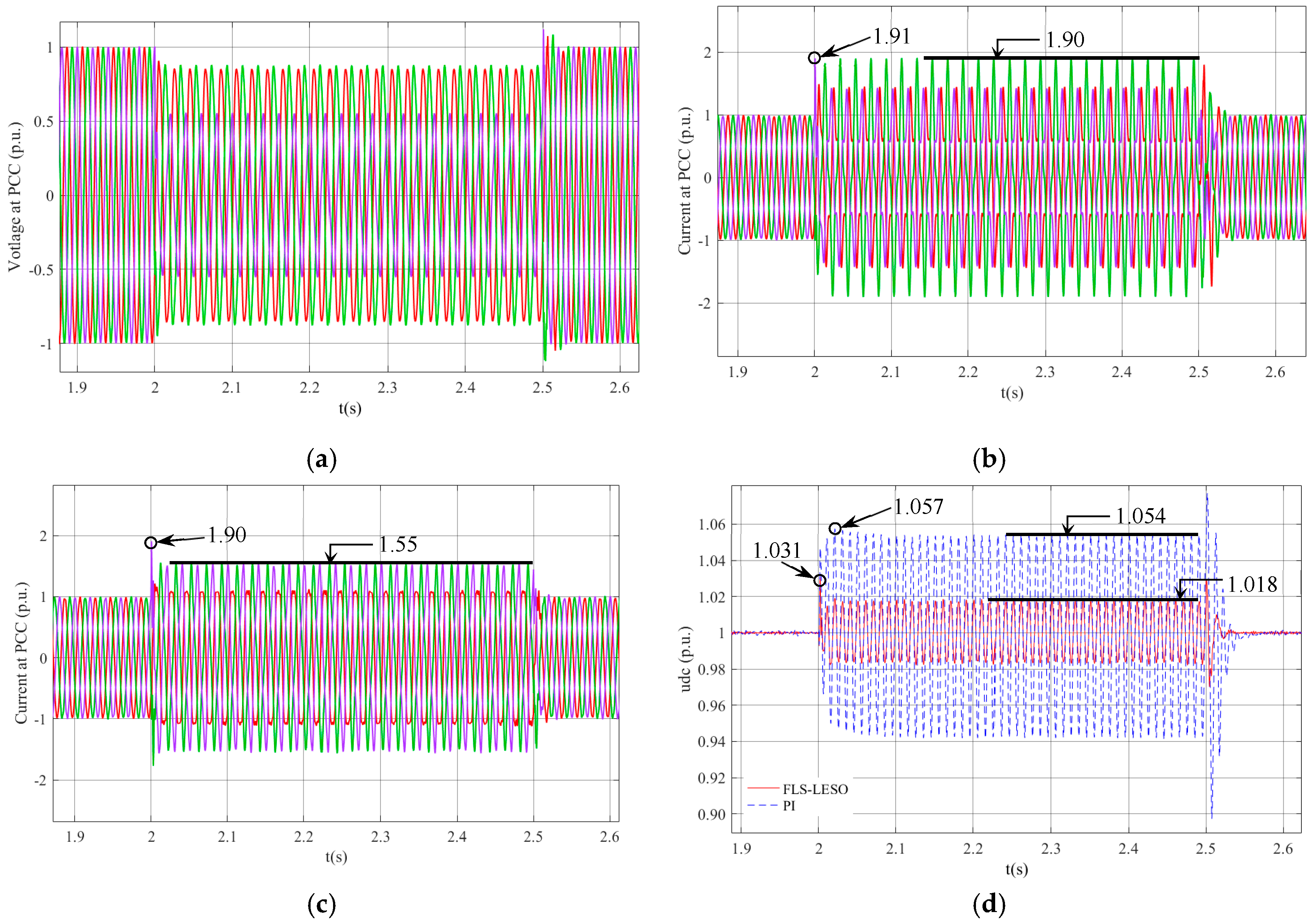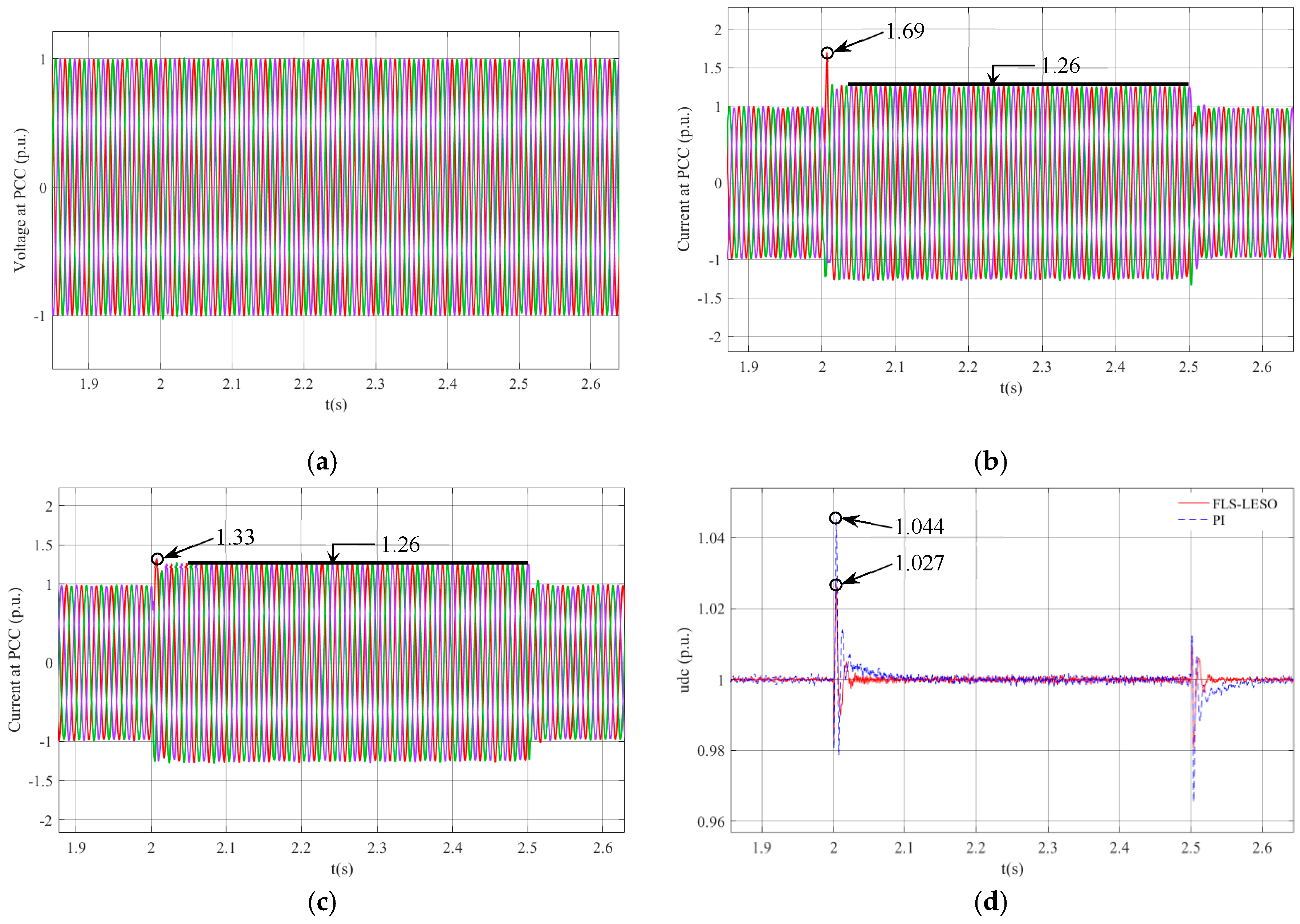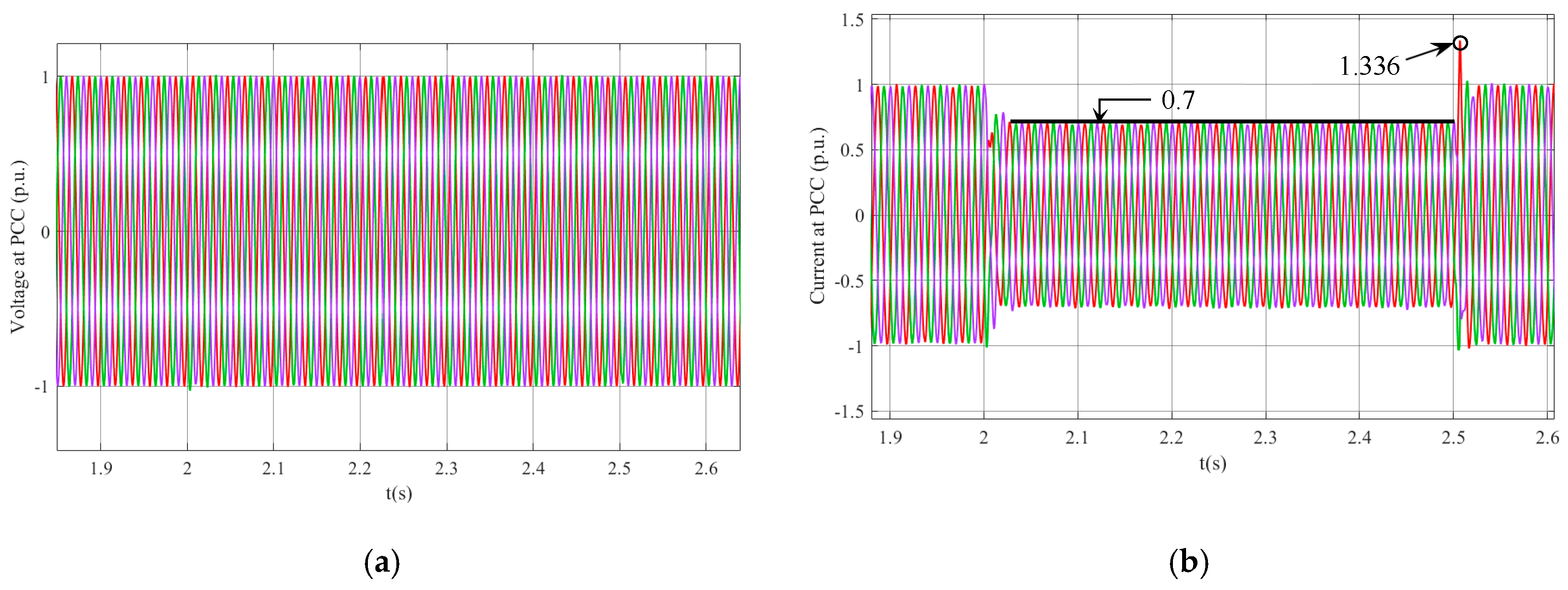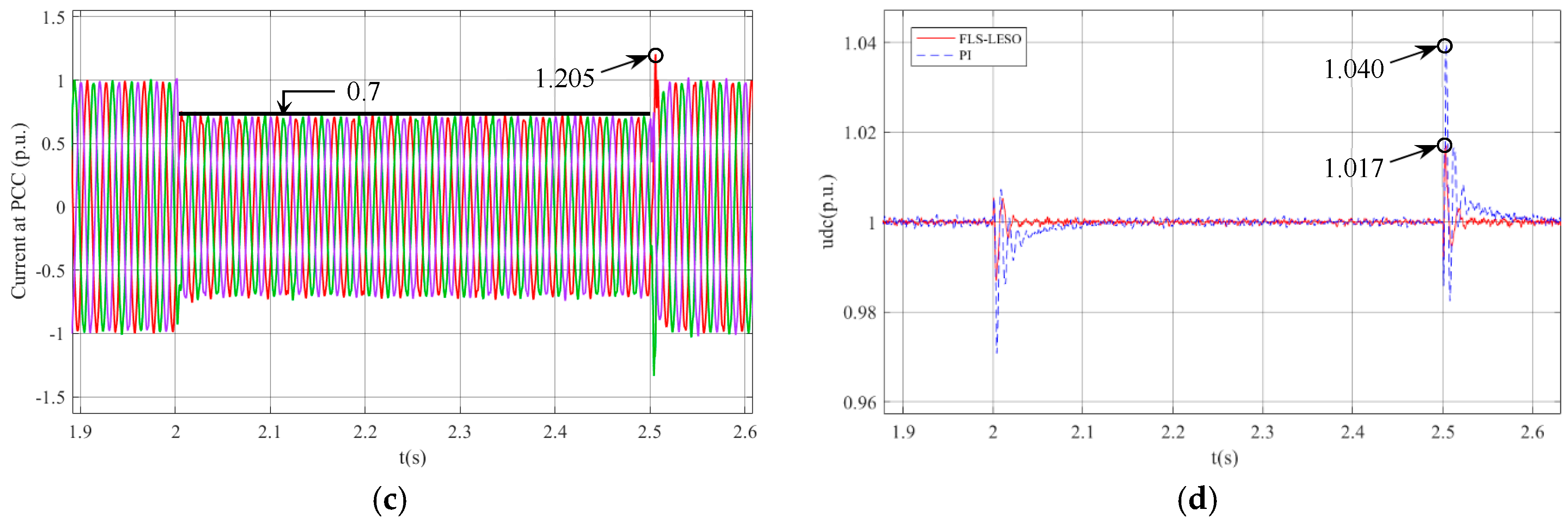1. Introduction
Because of the abundant necessity of energy harvest and continuous depletion of fossil fuels, demands of renewable energy sources are gaining more attention [
1,
2]. There are many methods of generating electricity from renewable sources, such as the wind turbine and solar panel. Wind turbines, which convert wind energy into electrical energy, are the most important of these methods. Many types of generator are used in wind turbines [
3,
4]. A permanent magnet synchronous generator (PMSG) has recently begun to attract the attention of wind turbine manufacturers due to its superior features. The PMSG is supplied to the electrical grid system by means of the grid-side converter (GSC), machine-side converter (MSC), and control systems [
5,
6]. The fault ride-through (FRT) capability is one of the important issues for the operation system of the wind power system [
7,
8,
9,
10]. The grid connection requirements (GCRs) involve the operational condition control of the distributed power system [
11]. The GCRs have to provide efficiency and reliability to the electrical grid system. The wind turbine (WT) must remain connected to the electrical grid system during grid faults [
12]. The fault ride-through is depicted in three stages [
13]:
In the first stage, a WT constantly supplies an electrical power grid system during grid fault time or machine-side power fluctuates during grid normal time;
In the second stage, the machine-side power and the network side power cannot maintain the balance, the surplus energy accumulates in the DC bus and causes its voltage fluctuation;
In the third stage, through the output of the control system, the power of both sides of the converter is rebalanced.
All these requirements must be considered in the design of the controller and power converter of the WECS. This design increases the stability of the WECS during a grid fault [
14]. Therefore, it is of great practical significance to further study the control strategy to enhance the operation performance of wind power systems when grid-side voltage changes and machine-side power fluctuates.
Many methods are proposed in the literature for the FRT capability enhancement. The peak current limitation for a high-power PMSG was realized in Reference [
15]. Maximum power point tracking (MPPT) was implemented in the GSC and MSC. An active crowbar is kept the DC link voltage value by using this method [
16]. A superconducting fault current limiter (SFCL) was implemented for the FRT enhancement of a PMSG in Reference [
17]. However, this requires additional circuit links, which not only increases the design difficulty of WECS, but also increases the upfront investment and maintenance cost. The static synchronous compensator (STATCOM) has been implemented to analyze a dynamic mechanism for a wind farm [
18]. A coordinating control system for wind turbines was presented in Reference [
18]. However, STATCOM has disadvantages, such as high cost and additional hardware needs. A braking chopper (BC) system was implemented for the FRT enhancement of a PMSG in Reference [
19,
20,
21]. The presented method achieved reductions in the fault currents in DC systems. This method has some advantages, such as low cost and a simple control structure.
Recently, soft computing methods have started to develop rapidly with the development of computer technology. Soft computing methods are applied in real-world applications, such as renewable energy and automotive and motor control. Soft computing methods are widely implemented in wind power applications, such as for maximum power point tracking (MPPT) control, pitch control, fault diagnosis, wind power integration, wind turbine power control, and prediction of wind speed and power. Soft computing methods consist of four computing algorithms such as predictive method, genetic algorithm, artificial neural networks, and fuzzy logic controllers.
The fuzzy logic controller has a number of distinguishing advantages over conventional controllers. It is not so sensitive to variations of system structure, parameters and operation points and can be easily implemented in a large-scale nonlinear system. Furthermore, the fuzzy logic controller is a sophisticated technique that is easy to design and implement. In the past decade, many researchers have attempted to combine conventional proportional plus integral plus derivative (PID) controllers with fuzzy logic to improve controller performance [
22,
23,
24]. The fuzzy logic controller has two input signals, and the output signal of the fuzzy logic controller is the input signal of the conventional PID controller. Through fuzzy reasoning, the parameters are adjusted adaptively, and the transient process of the system is improved. But in the actual system, the derivative element is usually not used because of the noise signal. The sampling time of fuzzy controller determines the control precision. Too huge sample interval worsens the transition process, and too short sample time greatly increase the computation and input cost. In addition, the fuzzy logic control is a type of soft computing method that overcomes the uncertainties of some systems [
25]. Uncertainty is a natural part of intelligent systems in many applications. However, fuzzy logic control does not fully deal with the uncertainties of intelligent systems.
The LESO can be used to solve the core problem of the uncertainties of the model and disturbance observation in reference [
26]. Using the idea of state observer, the disturbance which affects the output of the controlled object is expanded into a new state variable, and a state observer which can observe the extended disturbance is established by using a special feedback mechanism. This LESO can observe disturbances and obtain estimates without relying on the perturbation generating model or direct measurement.
This paper designs a fuzzy logic system with linear extended state observer (FLS-LESO) to improve the control performance of the WECS. On the one hand, by introducing LESO to observe and compensate the disturbance, the negative effects such as slow response, easy oscillation and saturation of control quantity caused by the use of integral element are avoided. Moreover, the derivative element can be used in the system to further improve the tracking performance of the system. On the other hand, the adjustment burden of fuzzy controller is reduced by integrating some known system information into LESO. The sampling time of fuzzy controller can be increased appropriately to reduce the input cost of microcomputer. All simulation results proved that the presented a FLS-LESO has the capability to improve the FRT capability of a PMSG.
2. Wind Energy Conversion System
A WECS consists of a blade generator, control system, transformer, and power electronics components [
27], as shown in
Figure 1. Wind turbines convert wind energy into electrical energy. The direct-drive permanent magnet synchronous wind turbine is connected to the power grid through full power back-to-back converters. The machine-side converter controls the motor speed or torque to realize the maximum power tracking of wind energy [
28,
29]. The grid-side converter mainly stabilizes the DC bus voltage and controls the grid-connected power factor and power quality.
The topological structure of WECS is shown in
Figure 2. The inverter circuit adopts full bridge AC/DC converter. Bidirectional switching devices use six common emitter insulated-gate bipolar transistor (IGBT) switch sequences.
and
respectively represent the internal resistance, filter inductance and capacitance of the grid-side filter. The
is DC current and
is DC voltage. This system adopts the space vector modulation strategy. In order to improve disturbance immunity and meet the power quality requirements of smart grid, it is necessary to control the grid-connected inverter of wind power.
According to the topology shown in
Figure 2, KVL three-phase voltage equation can be obtained [
30,
31,
32]:
where
and
are the inverter voltages of three-phase network side.
and
represent three-phase grid voltages.
and
depict three-phase grid-side inverter currents.
The transformation matrix from the three-phase static coordinate system to the two-phase static coordinate system is:
The transformation matrix from the two-phase static coordinate system to the two-phase rotating coordinate system is:
After conversion:
where
and
are the voltages of the
q and
d loops in the inverter on the grid-side, respectively. The
and
depict the voltages of the
d and
q loops in the three-phase grid voltage, respectively.
and
represent
d and
q loops currents of the grid-side inverter, and
ω is the electric angular of the grid. The Equation (4) shows that
and
are controlled by
and
, and are influenced by
and
, voltage drop
and
, and grid voltage
and
.
The PMSG adopts a full power converter structure to completely isolate the direct drive permanent magnet motor from the power grid. In the case of low voltage fault, it is more conducive to the stable operation of the protection system. This topology makes its FRT capability much higher than that of the doubly fed induction generator (DFIG) system. However, there are still some problems such as high DC side voltage and converter overcurrent. Grid faults will have a great impact on direct drive WECS. From the perspective of energy transmission, the transient characteristics of PMSG wind energy conversion system under the fault of instantaneous grid voltage drop are analyzed, as shown in
Figure 3.
Through the machine-side converter, the permanent magnet synchronous generator (PMSG) input active power
to the DC bus. Ignoring the machine-side converter loss, the output power of the converter is equal to that of the generator:
where
and
are the voltages of the
q and
d loops in the stator, respectively. The voltages of the
and
are utilized to generate the reference three-phase sinusoidal voltage, and the
and
depict the currents of the
d and
q loops in the stator, respectively. The
is the DC bus current of the machine-side converter, and
is the DC bus voltage of the DC side.
Then, the capacitive current
id at the DC side is as follows:
where
C is the DC bus capacitance, and
is the DC bus current of the grid-side converter.
Ignoring the power loss of the power device, the input power of the grid-side converter is consistent with the input power of the power grid, as follows:
where
and
are the voltages of the
q and
d loops in the grid-side, respectively. The
and
depict the currents of the
d and
q loops in the grid ride, respectively.
During normal operation, the power on both sides of the converter keeps balance (
). The
is stable at a certain value, as follows:
According to the electrical theory, the storage energy of bus capacitor C in the intermediate DC link can is illustrated in the Equation (10), as follows:
Therefore, from the Equation (8), during normal operation of the power grid, is 0 and is a constant value. From the Equation (7), the active power sent by the converter to the power grid decreases when the power grid voltage falls in fault sags. During this period, assuming that the wind speed is constant, then the active power emitted by the machine-side is constant. The active power generated on the machine-side cannot be transmitted to the grid in time, resulting in . From Equations (5), (7), (9) and (10), the excess energy will build up on the DC side capacitor, causing the voltage to rise and the current flowing through the bus capacitor and the grid-side converter to increase rapidly. Excessive voltage and current can damage capacitors and other devices if not handled properly. In order to avoid losses and meet the requirements of smart grid on power quality, it is necessary to control the grid-connected inverter of wind power.
4. Design of a Controller for a Wind Energy Conversion System
The fuzzy control algorithm is used to design the wind turbine grid connection control strategy with parameter adaptive ability, and LESO is introduced into the wind power grid connection technology to solve the problem of voltage and power instability. The control diagram of output voltage and output current of the converter is shown in
Figure 8.
Under the traditional single closed-loop control strategy, feed-forward decoupling is often used to deal with the coupling term. Because this decoupling method increases the difficulty of controller design and the uncertainty of parameters, it is hindered in practical application. When inputs and outputs are in one-to-one correspondence, cross-effects (coupling) between channels are estimated by the LESO and eliminated as disturbances in each single input single output loop. In other words, the cross coupling is naturally decoupled, so the FLS-LESO has naturally decoupling characteristic. Due to the complexity and uncertainty of transient process dynamics, it is impossible for the process model to be completely accurate and reliable. Due to its natural decoupling capability, the FLS-LESO far outperforms PID and other model-based methods in controlling coupled systems, and its controller structure is shown in
Figure 9.
Figure 9.
FLS-LESO structure.
Figure 9.
FLS-LESO structure.
where
is the observed value of output,
is the observed value of the first derivative of output, and
is the observed value of the total disturbance.
For this WECS, we can obtain partial model information of wind power system. Integrating some of the known information into LESO can reduce the bandwidth of LESO or improve the estimation accuracy of disturbance without reducing the bandwidth of LESO. The LESO integrated system information has its particularity and uniqueness.
Where
is the equivalent time constant of sampling and filtering links, the 2
T represents the equivalent time constant of current inner ring, and
is the conversion link coefficient (0.75). The C depicts the capacitance parameter of DC bus. From the
Figure 10, The open-loop transfer function without control can be obtained, as follows:
Since
and
T are both small, small inertial element can be combined to simplify, as follows:
Carry out inverse Laplace transform to get the equivalent differential equation of the system. Assuming that
w is unknown and
is a known part of
b, as follows:
with
,
and
used as substitutions.
Suppose the total disturbance of actual unknown, as follows:
where
is the sum of the unknown total disturbance.
The sum of the unknown total disturbance and the known object information is regarded as the expansion of the disturbance and denoted as
f, as follows:
Select the state variable:
, then
is the expansion state including disturbance, which is transformed into the continuous state space description, as follows:
where
are LESO matrices.
Corresponding continuous LESO is, as follows:
where,
Z→
X,
Z is the state vector of the observer, and
L represents the observer gain matrix to be designed. Since
is unknown and can be estimated by correction,
is omitted. Rewrite the observer equation, as follows:
where
depicts the combined input, and
is the output.
After parameterization, all the observer poles are configured at
, as follows:
where
is the observer bandwidth. The observer gain matrix is calculated, as follows:
The FLS-LESO replaces the traditional control strategy to improve the output of the system in the outer ring of the converter. The two inputs of the fuzzy PD controller are the error (
) of the DC bus voltage, and the error derivative (
) of the DC bus voltage.
and
are the output language variable, and the range of variation is defined as the basic domain on fuzzy set. The basic domain of the two inputs
e and
is [−6,6], and their fuzzy sets are {NB, NM, NS, ZO, PS, PM, PB}. The basic domain of the two outputs
and
is [−0.6,0.6] and [−12,12], respectively. Their fuzzy sets are {NB, NM, NS, ZO, PS, PM, PB}. The elements in the subset represent negative big, negative middle, negative small, zero, positive small, positive middle and positive big. The quantity of continuous change in the basic domain is discretized and fuzzy processing is carried out. Set the range of variation of DC bus voltage deviation
e and deviation derivative
as [−6,6]. If not within this range, a continuous quantity with a value between [
a,
b] can be converted to [−6,6] by linear transformation.
In this paper, the control rules and membership functions are determined based on the trial and error and the designer experience. the membership functions are composed of three memberships functions (two-inputs and one-output) and each membership function has seven triangular memberships. For this case, controller rules are used as shown in
Table 1.
From the Equation (19), the general expression of the state space of the system can be obtained, as follows:
From Equations (28) and (29), the closed-loop system is obtained:
After Laplace transform, the following relations are obtained according to Routh criterion:
From Equation (31), the range of PD parameters can be obtained, and the upper and lower limits of the fuzzy PD controller can be designed to ensure the stability of the system operation. The output surface of fuzzy controller is shown in
Figure 11.
5. Simulation Study
The simulations in this study were realized in Matlab/Simulink to verify the effectiveness and analysis of the presented method. The sampling time of the presented Simulink system was modeled at 1 × 10
−6 s. The parameters of the PMSG and power converter systems are given in
Table A1, respectively. An open source FLCWR toolbox in Matlab/Simulink was used in this study. The rules of the FLS-LESO system were designed to maximize the wind energy conversion system. The fuzzy rules were adjusted to generate the optimized gains for the power performance of the wind system based on the PMSG. An FLS-LESO control system was implemented for the analysis of four different cases of grid-side and machine-side fault. The different types of symmetrical and asymmetrical faults were implemented separately at the proper time on the grid-side of the PMSG. The simulated fault conditions were as follows:
- (i)
The 50% symmetrical fault was implemented at t = 2.0 s and was cleared at t = 2.5 s;
- (ii)
The asymmetrical fault was implemented at t = 2.0 s and was cleared at t = 2.5 s;
- (iii)
The 30% increase in wind turbine power at t = 2.0 s and was cleared at t = 2.5 s;
- (iv)
The 30% decrease in wind turbine power at t = 2.0 s and was cleared at t = 2.5 s.
The generator with the proposed control method was connected to the grid during all grid fault types. The simulation results illustrate that the FLS-LESO gives an appropriate performance for the power generation of the wind system using a PMSG for different scenarios. The rated value of the DC link was 1070 V, the rated value of voltage was 1 p.u., and the rated value of the current was 1 p.u. in the study.
Scenario 1
The 50% symmetrical fault was implemented at t = 2.0 s, and then it was cleared at t = 2.5 s, as shown in
Figure 12a. The 50% symmetrical fault was the severer fault type used. Therefore, the control of this fault type is vital. The FLS-LESO and PI controller were separately implemented in the WECS. The parameters of the WECS that were measured were the DC link (
), grid voltage (
), and grid current (
). The maximum value of the current at the point of common coupling (PCC) with the PI controller was 2.09 p.u., and it fluctuates around 1.98 p.u., as shown in
Figure 12b. However, the maximum value of the current at the PCC with the FLS-LESO was 2.21 p.u., and it also fluctuates around 1.98 p.u., as shown in
Figure 12c. The DC link voltage of the system is given in
Figure 12d. The DC link peak voltage value using a PI controller was 1.06 p.u. during the grid fault, while the DC link peak voltage value with the FLS-LESO was 1.03 p.u. The oscillation of the DC link voltage value with the PI controller was higher than the proposed control system even after the grid fault time. The oscillation of the DC link voltage value with the PI controller was higher than the proposed control system even after the grid fault time.
Scenario 2
The asymmetrical fault was implemented at t = 2.0 s, and then it was cleared at t = 2.5 s, as shown in
Figure 13a. The asymmetrical fault was also severer fault type. The FLS-LESO and traditional PI controller were separately implemented in the system during the asymmetrical fault, as shown in
Figure 13a. The DC link, grid voltage, and grid current of the system with the FLS-LESO are given in
Figure 13b–d, respectively. The current at the PCC with the traditional PI controller system increased to 1.91 p.u., and it fluctuates around 1.90 p.u., as shown in
Figure 13b. However, the maximum value of the current at the PCC with the FLS-LESO was 1.90 p.u., and it fluctuates around 1.55 p.u., as shown in
Figure 13c. The overshoot value of the DC link with the traditional PI controller system was 1.057 p.u., as shown in
Figure 13d. The overshoot value of the DC link voltage with the FLS-LESO was 1.031 p.u., and the overshoot in the DC link voltage was greatly reduced by the FLS-LESO. The ripples in the DC link voltage value with the traditional PI controller system were higher than the proposed control system even after the grid fault time.
Scenario 3
The 30% increase in wind turbine power at t = 2.0 s and was cleared at t = 2.5 s, as shown in
Figure 14a. The wind turbine power fluctuation was lighter than the other fault types. However, the power fluctuation is the most common type of turbine side disturbance. Therefore, the control of this fault type is vital. The parameters of the WECS that were measured were the DC link, grid voltage, and grid current. The maximum value of the current at the point of common coupling (PCC) with the PI controller was 1.69 p.u., and it fluctuates around 1.26 p.u., as shown in
Figure 14b. However, the maximum value of the current at the PCC with the FLS-LESO was 1.33 p.u., and it also fluctuates around 1.26 p.u., as shown in
Figure 14c. The DC link voltage of the system is given in
Figure 14d. The DC link peak voltage value using a PI controller was 1.044 p.u., and the DC link peak voltage value with the FLS-LESO was 1.027 p.u. The overshoot value of the current at PCC and the DC link were greatly reduced by the FLS-LESO.
Scenario 4
The 30% decrease in wind turbine power at t = 2.0 s and was cleared at t = 2.5 s. The grid voltage remains constant during this period, as shown in
Figure 15a. The parameters of the WECS that were measured were the DC link, grid voltage, and grid current. The current at the PCC with the traditional PI controller system increased to 1.336 p.u., and it fluctuates around 0.7 p.u., as shown in
Figure 15b. However, the maximum value of the current at the PCC with the FLS-LESO was 1.205 p.u., and it also fluctuates around 0.7 p.u., as shown in
Figure 15c. The DC link peak voltage value using a PI controller was 1.040 p.u. during the grid fault, while the DC link peak voltage value with the FLS-LESO was 1.017 p.u., as shown in
Figure 15d The overshoot value of the current at PCC and the DC link were greatly reduced by the FLS-LESO.
The parameters with the proposed control system settled to the rated value within comparatively less time than with the traditional PI controller. The proposed control system reduced the ripples of all the parameters in the system due to the appropriate selection of FLS-LESO parameters.
6. Conclusions
The FRT capability of wind turbines is a vital issue for the electrical energy generated from wind energy and contributes to reliable grid integration. This paper proposes a new control approach using the FLS-LESO method that is implemented in the WECS based on a PMSG to improve the transient stability during grid faults and wind turbine power fluctuation. The main contributions of this work are:
- (i)
The FLS-LESO was designed to enhance the fault ride-through performance of the WECS in order to obtain effective results during grid faults;
- (ii)
The proposed control system was applied to control the GSC of the PMSG;
- (iii)
It was observed by measurements that the proposed control system protects the power of electronic devices from the harmful effect of overvoltage during grid faults;
- (iv)
The simulation results have confirmed that the proposed control system can effectively reduce the ripples of the parameters in the system.
The parameters of the system that were observed were the DC link, grid voltage, and grid current. The DC link of the system with the FLS-LESO had near nominal values. All the parameters of the system with the FLS-LESO closely tracked the rated values during and after the grid faults. All the parameters with the proposed control system settled to the rated value within comparatively less time than the traditional PI system. All the simulation results proved that the presented FLS-LESO scheme has the capability to improve the FRT capability of the WECS and performs better than the traditional PI system in all aspects.
In the future, the other rule evaluation method should be applied to the system. In addition, different fuzzy logic control systems, such as the interval fuzzy logic control with LESO, can be adapted to improve the FRT performance of WECSs, and the results can be compared with the results in this paper.
